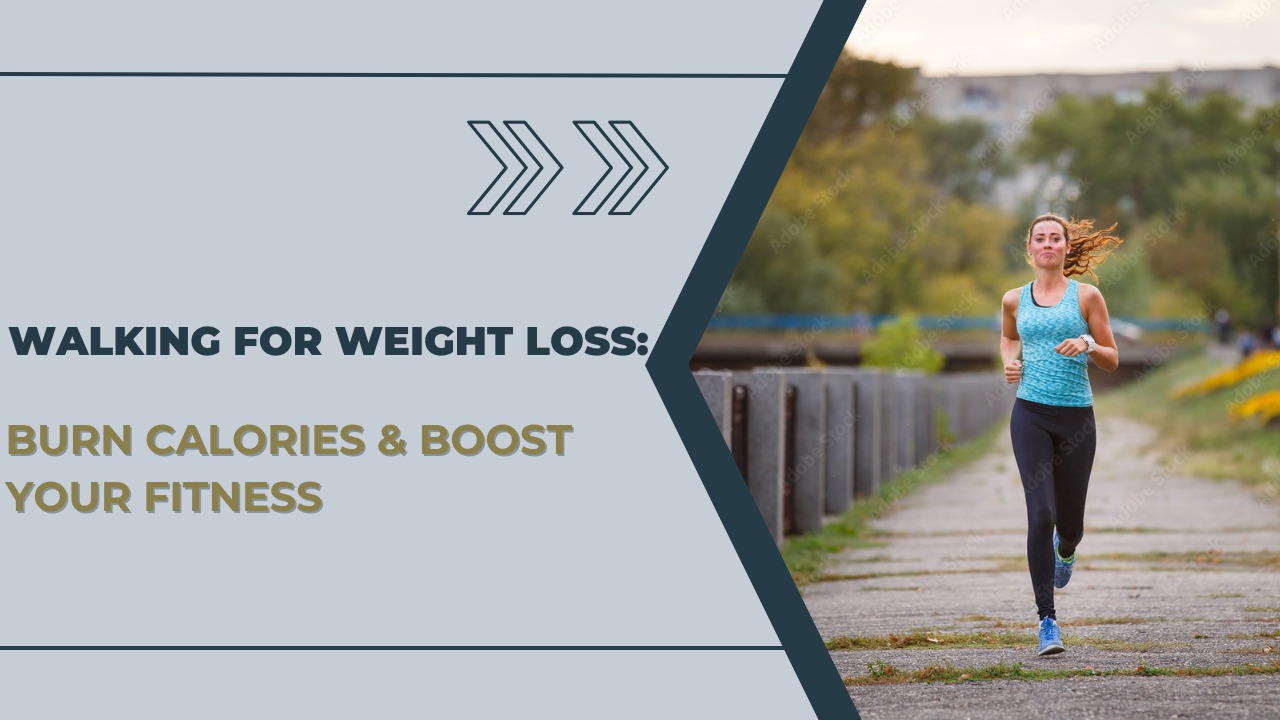In today’s world of high-intensity workouts, expensive gym memberships, and trendy diets, we often overlook one of the most accessible and underrated forms of exercise—walking. Surprisingly, walking for weight loss can be a simple yet highly effective strategy for shedding pounds and improving overall health.
This low-impact activity not only burns calories but also improves cardiovascular health, boosts metabolism, and reduces stress. Walking is suitable for all fitness levels and can easily be incorporated into daily routines. Whether you’re new to fitness or seeking a sustainable approach, walking for weight loss offers a practical and achievable solution.
In this guide, we’ll dive into how walking supports fat loss, share scientific insights, offer tips to increase your results, and provide real-life success stories. You’ll also get a step-by-step plan to help you begin your walking for weight loss journey with confidence and consistency—no equipment or gym required.

Why Walking Works for Weight Loss
When it comes to sustainable fat loss, walking often gets overlooked in favor of intense workouts. However, walking for weight loss is a proven and effective method that offers numerous health benefits without the strain of high-impact exercise. It’s accessible, low-cost, and suitable for people of all fitness levels.
One of the key reasons walking works is its ability to burn calories consistently over time. A brisk 30-minute walk can burn around 150 calories or more, depending on your pace and body weight. When done regularly, these calorie burns add up and can lead to significant weight loss.
Another advantage of walking for weight loss is its low risk of injury. Unlike running or intense cardio sessions, walking is gentle on the joints, making it ideal for those with mobility issues or beginners starting their fitness journey.
Additionally, walking helps regulate appetite and reduces stress, both of which play critical roles in weight management. Incorporating daily walks into your routine not only supports physical health but also boosts mental well-being—making weight loss feel less like a chore and more like self-care.
The Science Behind Walking and Weight Loss
Walking for weight loss is effective because it helps create a calorie deficit—burning more calories than you consume. When you walk briskly, your body taps into stored fat for energy, gradually reducing your fat reserves. Studies have shown that walking 30–60 minutes daily can significantly impact body weight and fat loss over time.
Additionally, walking for weight loss supports metabolism and boosts insulin sensitivity, which helps your body manage blood sugar more effectively. It also lowers cortisol levels, the stress hormone linked to fat storage. Unlike intense workouts that may increase hunger, walking often curbs appetite, making it easier to control calorie intake and maintain consistent progress without feeling deprived.
How Much Walking Do You Need?
The amount of walking for weight loss you need depends on your goals, fitness level, and lifestyle. In general, walking for at least 30 to 60 minutes a day, five times a week, is a great starting point. A brisk pace—where you can talk but not sing—helps burn more calories and improves cardiovascular health.
To lose a pound of fat, you need to burn approximately 3,500 calories. This means walking around 10,000 steps daily can contribute significantly to weight loss when combined with a healthy diet. Consistency is key—building walking into your daily routine, such as walking after meals or choosing stairs over elevators, can accelerate your walking for weight loss results effectively and sustainably.
Best Walking Techniques for Maximum Fat Burn

To maximize the benefits of walking for weight loss, it’s essential to walk correctly and consistently. Here are some techniques to help:
Walk at a Brisk Pace To make the most of walking for weight loss, aim for a brisk pace—around 3.5 to 4 mph. At this speed, you should feel slightly out of breath but still be able to hold a conversation. Walking briskly raises your heart rate, burns more calories, and promotes fat loss more effectively than a leisurely stroll. It also enhances your cardiovascular endurance over time. Try to maintain this pace for at least 30 minutes a day to see results. A brisk walk turns a simple routine into a powerful tool for sustainable and low-impact weight management.
Include Interval Walking Boost the benefits of walking for weight loss by adding interval training to your walks. Alternate between faster and slower walking speeds—for example, walk briskly for two minutes, then slow down for one minute to recover. These intervals increase calorie burn, improve heart health, and make your workouts more engaging. This method also stimulates your metabolism more effectively than a steady pace alone. Interval walking can be tailored to your fitness level and gradually intensified as you build stamina, making it a versatile and efficient strategy for losing weight through walking.
Use Proper Form Maintaining good posture and technique is essential when practicing walking for weight loss. Stand tall with your shoulders relaxed and avoid leaning forward. Swing your arms naturally to increase momentum and engage more muscles. Step from heel to toe in a smooth, rolling motion, which supports joint health and balance. Keep your core muscles slightly engaged to improve stability and posture. Proper walking form not only prevents injuries but also enhances the effectiveness of each step, ensuring you’re burning maximum calories and strengthening key muscle groups while staying safe during your walk.
Add Inclines Including hills or inclines into your walk can significantly boost the results of walking for weight loss. Walking uphill or using an incline treadmill increases intensity and challenges your muscles, particularly the glutes, hamstrings, and calves. This added resistance helps you burn more calories in a shorter amount of time. It also builds strength and endurance while adding variety to your routine. Even short bursts of incline walking can make a big difference over time. Gradually increase the slope or frequency to keep progressing and make your walks more efficient for weight loss and toning.
Tips to Stay Motivated and Consistent
Walking is one of the easiest and most effective ways to stay active, but maintaining consistency can be tough without the right approach. When using walking for weight loss as your fitness strategy, motivation and habit-building become key. By setting clear goals, tracking progress, and adding fun elements like music or a walking buddy, you make the journey enjoyable and sustainable. Small rewards for milestones also boost morale. These simple strategies help you stay committed and turn walking into a lifelong habit that supports your weight loss and overall health.

Set Clear Goals : Setting SMART goals is essential for success with walking for weight loss. Define what you want to achieve by making goals specific, measurable, and time-bound. For example: “I will walk 30 minutes, five days a week for three months.” Clear goals provide direction, increase focus, and make it easier to track your progress and stay motivated.
Track Your Progress Using a pedometer, fitness tracker, or smartphone app to monitor your steps and calories burned helps keep your walking for weight loss journey on track. Tracking creates accountability and motivates you to push harder. Watching your progress build over days and weeks encourages consistency and gives you a tangible sense of achievement as you work toward your goals.
Create a Walking Playlist Music is a great way to energize your walks and improve focus during walking for weight loss. Choose upbeat songs that keep your pace brisk and make your workouts feel more fun. A motivating playlist can help distract from fatigue, making it easier to walk longer and more consistently without feeling bored or tired.
Walk with a Buddy Walking with a friend or family member makes walking for weight loss more enjoyable and less of a chore. A walking buddy provides social support, accountability, and friendly competition, all of which help keep you committed. Sharing this journey with someone else makes it easier to stay consistent and turn walking into a rewarding habit.
Reward Yourself Celebrating milestones along your walking for weight loss journey keeps motivation high. Reward yourself when you hit weekly step goals or consistently walk for a month. Choose non-food treats like a massage, new workout gear, or a movie night to reinforce positive habits and make your progress feel rewarding and satisfying.
Walking and Diet: A Winning Combination
While walking burns calories, combining it with a healthy diet supercharges your weight loss results. Focus on nutrient-dense foods like:
Lean proteins (chicken, tofu, legumes)

Whole grains (brown rice, quinoa, oats)
Fruits and vegetables
Healthy fats (avocados, nuts, olive oil)
Avoid processed foods, sugary beverages, and excessive alcohol. Keeping a food diary or using a calorie-tracking app can help you stay within your daily calorie goals.
Sample Walking Plan for Weight Loss
Here’s a simple 4-week walking plan tailored for beginners who want to use walking for weight loss:
Week 1
Frequency: 5 days/week
Duration: 20–30 minutes
Pace: Moderate
Goal: Establish routine
Week 2
Frequency: 5–6 days/week
Duration: 30–35 minutes
Pace: Brisk with 1-minute intervals
Goal: Increase intensity
Week 3
Frequency: 6 days/week
Duration: 35–45 minutes
Pace: Brisk, include inclines
Goal: Burn more calories
Week 4
Frequency: 6 days/week + optional weekend hike
Duration: 45–60 minutes
Pace: Brisk with 5-minute fast intervals
Goal: Maximize fat burn
Repeat or modify this plan according to your progress and goals.
Real-Life Success Stories
Sarah’s 30-Pound Transformation After struggling with gym routines, Sarah turned to walking for weight loss. She started with 20-minute walks daily and gradually increased her time and pace. Within six months, she lost 30 pounds. Walking helped her stay consistent, reduced stress, and improved her overall health without needing expensive memberships or intense workouts.
Mike Reversed His Pre-Diabetes At 52, Mike was diagnosed with pre-diabetes. Instead of medications, he committed to walking for weight loss—starting with 10,000 steps a day. Over eight months, he shed 25 pounds and improved his blood sugar levels. Walking gave him control over his health in a sustainable, low-impact way that fit into his daily routine.
Garima Postpartum Journey After giving birth, Garima struggled with weight gain and fatigue. She began walking for weight loss by strolling with her baby in a stroller each morning. This gentle routine helped her lose 20 pounds in four months, lifted her mood, and gave her valuable bonding time—all while rebuilding her fitness slowly and safely.
David Found a Mental Health Boost Dealing with stress and weight gain, David chose walking for weight loss as a daily habit. Beyond losing 15 pounds in three months, he noticed significant mental health improvements. The fresh air, movement, and rhythm of walking became his stress relief. It transformed his mornings and gave him renewed focus and energy.
Conclusion: A Step in the Right Direction

Walking for weight loss may appear too basic to be effective, but its simplicity is exactly what makes it so sustainable and powerful. Unlike high-intensity workouts or complicated diet plans, walking requires no special equipment, costs nothing, and carries minimal risk of injury. It’s a natural, low-impact way to burn calories, boost metabolism, and improve overall health. Plus, it’s accessible to people of all ages and fitness levels.
The beauty of walking for weight loss lies in its flexibility. Whether you prefer walking in the morning sunshine, during lunch breaks, or after dinner, you can tailor it to fit your lifestyle. Consistency matters more than intensity. You don’t need to push yourself to exhaustion—just commit to moving every day. Over time, these small, consistent efforts lead to noticeable and lasting results, both physically and mentally.
Whether you’re just starting your weight loss journey or searching for a long-term, manageable fitness routine, walking is truly a step in the right direction. Lace up your shoes, step outside, and start moving toward a healthier, happier version of yourself. Because with walking for weight loss, the most important step isn’t the fastest—it’s the first one you take.
FAQs
How long should I walk each day for weight loss ?
For effective walking for weight loss, aim to walk at least 30 to 60 minutes daily at a brisk pace. Consistency is key, and combining walking with a balanced diet can accelerate your results.
Can I lose weight just by walking without changing my diet ?
While walking for weight loss burns calories, combining it with healthy eating will produce better and faster results. However, walking alone can still contribute to gradual weight loss over time.
What pace should I maintain during my walks ?
For walking for weight loss, a brisk pace—around 3.5 to 4 mph—is recommended. You should feel slightly out of breath but still able to hold a conversation comfortably.
Is walking on a treadmill as effective as walking outdoors ?
Yes, both options support walking for weight loss. Walking on a treadmill allows for controlled pace and incline, while outdoor walking provides variety and natural scenery to keep you engaged.
Do I need to walk every day to see results ?
You don’t need to walk daily, but aiming for at least 5 days a week helps maintain momentum in your walking for weight loss journey. Regular activity delivers the best results.

